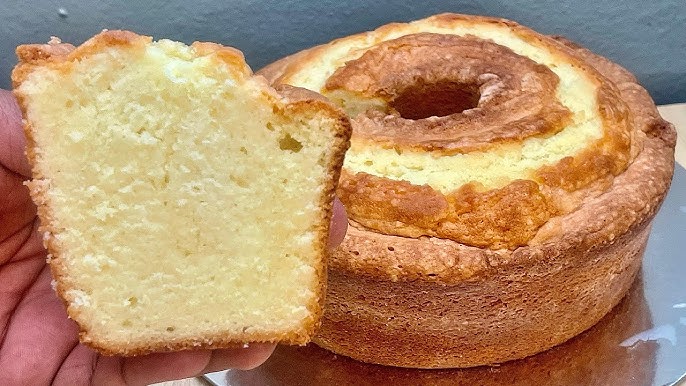Best Pound Cake Recipe: There’s something deeply comforting about a slice of freshly baked pound cake. With its rich, buttery flavor and tender crumb, pound cake has earned a spot in the hall of fame for classic desserts. It’s versatile enough to serve at tea time, as a celebration cake, or even as a base for layered trifles and desserts.
A Brief History of Pound Cake
The pound cake has its roots in Europe, dating back to the early 1700s. Originally, it was named for the simple ratio of its core ingredients: one pound each of flour, butter, sugar, and eggs. This straightforward formula made it easy to remember, even for cooks who didn’t have written recipes.
Over time, the recipe evolved across cultures, especially in America where leavening agents like baking powder and flavorings such as vanilla were added to enhance its texture and taste. Despite the tweaks, the name “pound cake” stuck, honoring its humble and hearty beginnings.
Why It’s Called “Pound” Cake
The original name is no mystery—“pound cake” came from the fact that the traditional recipe required a pound of each of the main ingredients. This resulted in a large, dense cake perfect for feeding a crowd. Today’s recipes are scaled down, but the essence remains the same: a rich, dense cake with plenty of butter and a melt-in-your-mouth texture.
Ingredients You’ll Need
Pound cake may seem simple, but each ingredient plays a critical role in achieving that iconic texture and taste.
Key Ingredients for Traditional Pound Cake
Here’s what you’ll need for the classic pound cake:
- Butter (1 cup or 2 sticks): Use unsalted and bring it to room temperature.
- Sugar (2 cups): Granulated white sugar is ideal for sweetness and texture.
- Eggs (4 large): Also at room temperature for better emulsification.
- All-purpose flour (3 cups): The foundation of the cake.
- Milk (1 cup): Adds moisture and helps create a smooth batter.
- Vanilla extract (2 tsp): For that sweet, fragrant finish.
- Salt (½ tsp): Balances the sweetness.
Optional Add-ins for Flavor Variation
Want to spice things up a bit? Try these popular variations:
- Lemon or orange zest for a citrusy kick.
- Almond extract in place of or alongside vanilla.
- Chocolate chips, berries, or nuts mixed into the batter.
- A rum or vanilla glaze drizzled over the top for added sweetness.
Tools and Equipment Required
Getting the right tools makes baking more efficient and ensures consistent results.
Baking Tools Checklist
- Stand or hand mixer: Essential for creaming butter and sugar properly.
- Mixing bowls: Preferably one large and one medium.
- Measuring cups and spoons: Accuracy matters.
- Sifter or fine-mesh strainer: Helps aerate the flour for a finer crumb.
- Rubber spatula: To scrape down sides and fold batter.
Choosing the Right Pan
Traditionally, pound cakes are baked in a loaf pan or a bundt pan. Bundt pans give a decorative edge and help distribute heat evenly, while loaf pans offer a classic bakery-style presentation. Ensure the pan is greased and floured thoroughly to prevent sticking.
Step-by-Step Instructions
Let’s roll up our sleeves and dive into the heart of this recipe. Here’s how to make the best pound cake, step by step.
Step 1: Preparing Your Ingredients
Preparation is key. Take the butter and eggs out of the fridge at least 30 minutes before baking. Preheat your oven to 325°F (163°C). Grease your chosen baking pan generously with butter or non-stick spray, then dust lightly with flour.
Step 2: Creaming Butter and Sugar
In a large mixing bowl, beat the butter until smooth and creamy—this usually takes about 2-3 minutes. Gradually add in the sugar and beat on medium-high speed until the mixture is light and fluffy. This process is crucial; it incorporates air into the batter, giving the cake a lighter texture.
Step 3: Adding Eggs One at a Time
Add the eggs one at a time, beating well after each addition. This ensures the eggs fully emulsify with the butter-sugar mixture. If you add them too quickly, the batter might curdle. Take your time here—it’s worth the patience.
Step 4: Sifting and Mixing the Flour
Now it’s time to incorporate the dry ingredients. In a separate bowl, sift together the flour and salt. Sifting is often skipped, but it’s a small step that makes a big difference—it prevents lumps and gives the cake a finer, lighter crumb.
Gradually add the dry ingredients to the wet mixture, alternating with the milk. Start and end with the flour. For example, add ⅓ of the flour, then ½ of the milk, and repeat until all ingredients are mixed in. Stir gently, just until combined. Overmixing at this stage can lead to a tough, dry cake.
Use a rubber spatula to give the batter a final stir, making sure to scrape the bottom and sides of the bowl to incorporate any stray flour.
Step 5: Baking to Golden Perfection
Pour the batter into your prepared pan and smooth the top with a spatula. Tap the pan gently on the counter to remove any air bubbles. Place it in the preheated oven on the middle rack.
Bake for 60–70 minutes, depending on your oven and pan size. Do not open the oven door in the first 45 minutes—this can cause the cake to collapse. Start checking for doneness around the 60-minute mark. Insert a toothpick into the center of the cake; if it comes out clean or with just a few moist crumbs, the cake is done.
If the top is browning too quickly but the center is still undercooked, loosely cover the cake with aluminum foil and continue baking.
Step 6: Cooling and Serving
Remove the cake from the oven and let it cool in the pan for 15 minutes. Then carefully transfer it to a wire rack to cool completely. This helps the cake set and prevents sogginess on the bottom.
Once cooled, you can serve the pound cake as is, or dust it with powdered sugar for a classic touch. For a more indulgent treat, add a glaze or serve it with fresh berries and whipped cream.
Pro Tips for the Perfect Pound Cake
Even though pound cake is relatively simple, there are a few tricks to elevate it from good to outstanding.
Avoiding Common Mistakes
- Don’t rush the creaming step. It’s crucial for structure and texture.
- Measure ingredients accurately. Baking is science, and small deviations can change the outcome.
- Use room temperature ingredients. This helps everything blend smoothly.
- Don’t overmix once the flour is added. This can lead to a dense, chewy cake.
Enhancing Moisture and Flavor
- Swap part of the butter for cream cheese or sour cream for extra moisture.
- Add a teaspoon of baking powder if you like a slightly lighter texture.
- Don’t forget the salt—it intensifies the flavors.
- Brush the cake with simple syrup after baking for added moisture and sweetness.
Variations You Can Try
If you’ve mastered the classic pound cake, here are two flavor-packed versions to experiment with.
Lemon Pound Cake
Zest and juice of one large lemon added to the batter will brighten the flavor profile. A simple lemon glaze (powdered sugar + lemon juice) drizzled on top makes it even more irresistible. This version is great for spring gatherings and summer tea parties.
Chocolate Marble Pound Cake
To create a marbled effect, divide your batter in half. Stir ¼ cup of cocoa powder into one half. Alternate spoonfuls of each batter into your pan, then swirl with a knife before baking. It’s rich, stunning, and adds a whole new layer of flavor.
Storage and Shelf Life
Proper storage helps preserve the texture and flavor of your pound cake for days.
How to Store Pound Cake Properly
Once the cake has cooled completely, wrap it tightly in plastic wrap or store it in an airtight container. It can be kept at room temperature for up to 4 days. Avoid storing it in the fridge unless you live in a very warm climate, as refrigeration can dry it out.
Can You Freeze Pound Cake?
Absolutely! Pound cake freezes beautifully. Wrap slices or whole loaves in plastic wrap and then in foil or a freezer bag. Label it with the date, and freeze for up to 3 months. To thaw, leave it at room temperature for several hours or overnight.
Nutritional Information
| Nutrient | Per Slice (1/12 cake) |
|---|---|
| Calories | 430 |
| Total Fat | 22g |
| Saturated Fat | 13g |
| Carbohydrates | 52g |
| Sugars | 30g |
| Protein | 6g |
| Sodium | 180mg |
(Note: Values are approximate and may vary depending on ingredients used.)
FAQs about Pound Cake Recipe
1. What makes pound cake dense but tender?
The high fat content from the butter and eggs makes pound cake dense, while proper creaming and room temperature ingredients ensure it stays tender.
2. Can I use cake flour instead of all-purpose flour?
Yes, but cake flour will yield a softer, finer crumb. Reduce the total amount slightly when using cake flour to avoid a too-light texture.
3. Why did my pound cake fall in the middle?
This usually happens if the cake is underbaked or if the oven door was opened too early. Make sure it’s baked through and avoid disturbing it.
4. How do I make pound cake more moist?
Add sour cream, cream cheese, or brush the cake with syrup after baking. These tips help lock in moisture and boost flavor.
5. Can I use a hand mixer instead of a stand mixer?
Definitely. A hand mixer works just fine, though it may take a bit longer to reach the desired consistency during creaming.
Conclusion
There’s a reason pound cake has stood the test of time. It’s easy to make, incredibly delicious, and endlessly versatile. Whether you stick with the classic version or experiment with bold flavors, pound cake is a dessert that never goes out of style. Try this recipe once, and it’s bound to become a staple in your kitchen.



